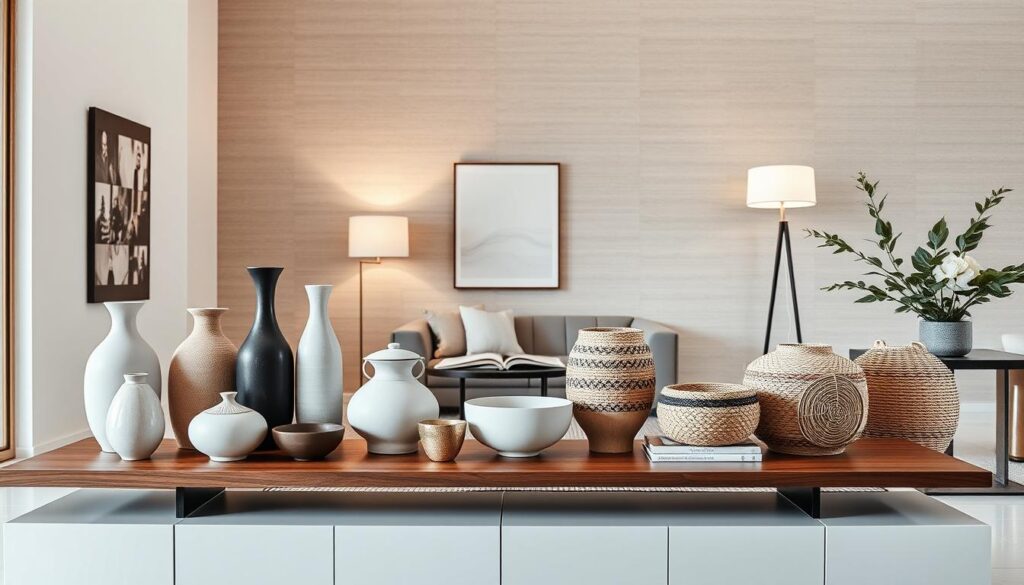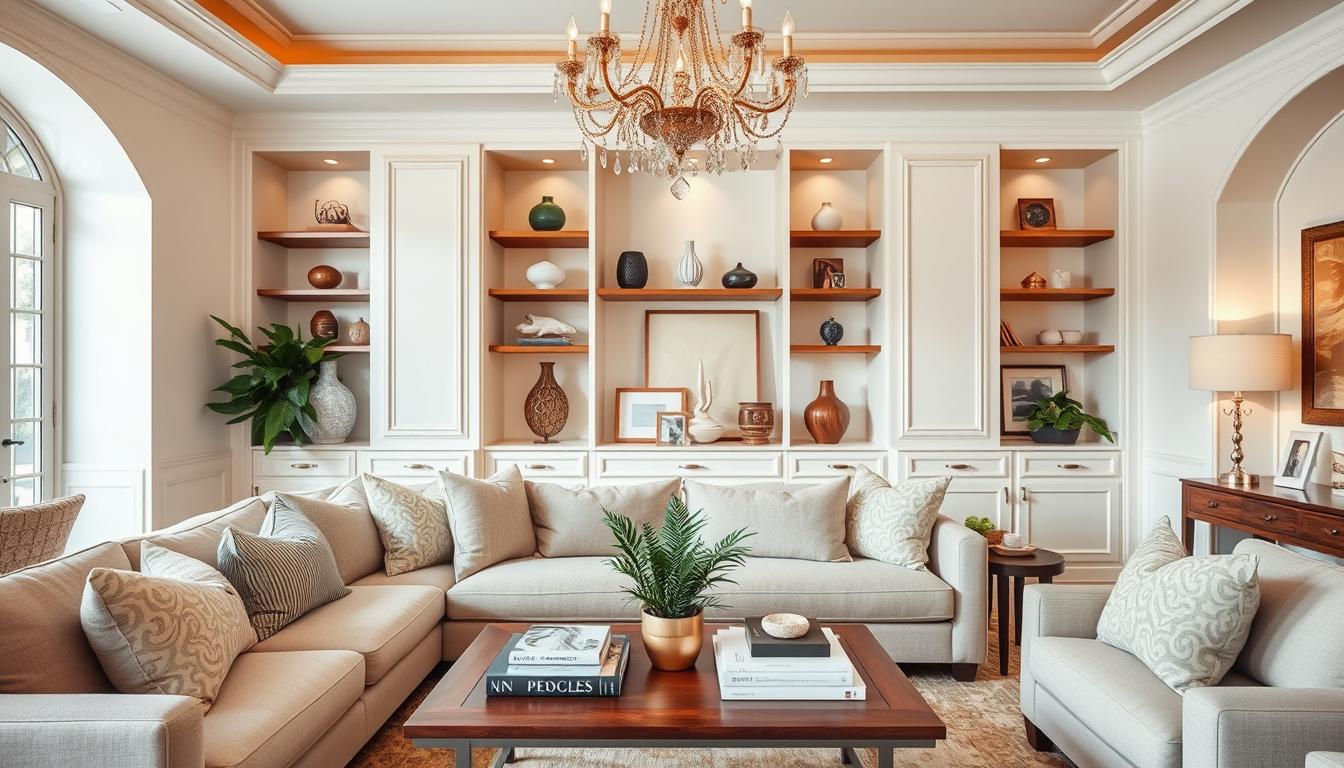Did you know a well-designed living space can make you happier and more productive? Today’s home decoration trends are all about being green, healthy, and useful. It’s now simpler than ever to turn your home into a cozy retreat.
We’re thrilled to share our top 10 interior home decor ideas to refresh your space. We’ll dive into styles like Japandi, bold colors, and textured walls. These are the hottest trends in home decor right now.
Key Takeaways
- Discover the latest home decoration trends that combine style with functionality.
- Explore the Japandi style and its emphasis on minimalism and natural materials.
- Learn how to incorporate bold colors and textured walls into your space.
- Understand the importance of wellness-focused spaces in modern home decor.
- Get inspired to transform your home with our top 10 interior home decor ideas.
1. Embrace Minimalism for a Clean Aesthetic
Minimalism is more than a design trend; it’s a lifestyle. It turns your living space into a calm oasis. By embracing minimalism, you can make your space clean and clutter-free. This promotes relaxation and clarity.
Defining Minimalism in Decor
Minimalist decor is simple, with clean lines and a few colors. It makes your space feel open and airy, without clutter. Japandi style is a great example of minimalist decor.
It mixes Japanese and Scandinavian design. It uses natural materials, neutral colors, and cozy elements. This creates a welcoming space.
Key Elements of Minimalist Design
To get a minimalist look, focus on these key elements:
- Natural Materials: Use wood, stone, and plants for warmth and texture.
- Neutral Color Palette: Choose whites, grays, and beiges for calmness.
- Cozy Elements: Add throw blankets, pillows, and warm lighting for coziness.
- Clean Lines: Pick furniture with simple designs to keep it open.
These elements help you create a stylish, functional space. It follows modern interior design and offers tips for a clutter-free home.
2. Play with Bold Colors for a Vibrant Impact
In 2025, bold and bright colors are big in interior design. Using bold colors can change a room, making it lively and interesting. We’ll look at how to use bold colors in your home decor.
Choosing a Color Palette
Choosing the right color palette is key with bold colors. A good palette makes a room look cohesive and nice. But a bad one can make it feel chaotic.
Start by picking a main color that shows your personality or fits your decor. Then, pick one or two secondary colors that go well with the main color but don’t take over.
For example, if you love rich colors, choose emerald green as your main color. Pair it with beige or gray for a nice contrast. Or, pick a bright color like coral or turquoise for a bold accent in a calm room.
| Color Type | Dominant Color | Secondary Color | Accent Color |
|---|---|---|---|
| Jewel Tones | Emerald Green | Beige | Gold |
| Bold Accents | Neutral Gray | White | Coral |
| Monochromatic | Blue | Light Blue | Dark Blue |
Tips for Adding Color Without Overwhelming
When using bold colors, aim for a balance. Here are some tips to add color well:
- Start with a neutral base: Use a neutral wall, furniture, or floor as a calm background for bold colors.
- Use the 60-30-10 rule: Use 60% of the room for a main color, 30% for a secondary color, and 10% for an accent color for balance.
- Add color through accessories: Use throw pillows, blankets, or vases in bold colors to add interest without overwhelming the space.
By choosing colors wisely and following these tips, you can make a space that’s lively and shows your style. Whether you like rich colors or bold accents, have fun trying different colors until you find the right mix for your home.
3. Incorporate Natural Elements in Your Space
Adding natural elements to your home decor can make you feel better and connect you to nature. Biophilic design makes your home look great and helps your health and the planet.
Benefits of Biophilic Design
Biophilic design lowers stress, boosts mood, and increases productivity. It brings a sense of calm and well-being to your home.
Some key benefits of biophilic design include:
- Improved air quality
- Enhanced mental health
- Increased connection to nature
Experts say biophilic design is more than plants or natural materials. It’s about making a space that cares for your body and mind. This design makes us think differently about nature and our homes.
| Natural Element | Benefits | Examples |
|---|---|---|
| Indoor Plants | Purify air, reduce stress | Snake plants, peace lilies |
| Natural Materials | Add warmth, texture | Wood, stone, bamboo |
| Reclaimed Wood | Sustainable, unique character | Reclaimed oak, pine |
Ideas for Indoor Plants and Natural Materials
Starting with indoor plants is a good way to add natural elements to your decor. Plants clean the air and bring greenery to your space. For more ideas, check out Greenhouse Studio.
Use wood, stone, or bamboo to add warmth and texture. Reclaimed wood is sustainable and adds a special touch to your home.
By using these elements, we can make our homes feel more connected to nature. This improves our well-being and quality of life.
4. Layer Textures for Depth and Interest
Layering textures is a simple yet effective way to add depth and visual interest to any room in your home. By incorporating a mix of different textures, you can create a cozy and inviting atmosphere that reflects your personal style.
Mixing Fabrics and Finishes
Mixing fabrics and finishes is key to layering textures. This means combining smooth surfaces like glass or metal with rougher textures like wood or woven fibers. For example, pairing a sleek leather sofa with a chunky woven rug and a wooden coffee table can add depth and visual interest to a living room.
To achieve a balanced look, it’s essential to mix different textures thoughtfully. Start with a dominant texture, such as a plush area rug, and then add contrasting textures like a smooth wooden side table or a velvet armchair. This contrast will create a visually appealing space that feels layered and interesting.

Creating a Cozy Atmosphere
Layering textures is also crucial for creating a cozy atmosphere in your home. Soft fabrics like throw blankets, pillows, and rugs can add warmth and comfort to a room. Consider combining different materials like wool, cotton, and fleece to create a layered look that’s both inviting and cozy.
| Texture | Examples | Benefits |
|---|---|---|
| Smooth | Glass, Metal, Leather | Adds a sleek, modern touch |
| Rough | Wood, Woven Fibers, Brick | Creates warmth and coziness |
| Soft | Throw Blankets, Pillows, Rugs | Adds comfort and warmth |
By thoughtfully layering different textures, you can create a modern interior design that feels both stylish and cozy. Whether you’re decorating a living room, bedroom, or dining room, incorporating a mix of textures is a simple and effective way to add depth and visual interest to your space. For more ideas on affordable home decor, consider exploring local thrift stores or online marketplaces for unique, budget-friendly finds.
5. Utilize Mirrors to Enhance Light and Space
Mirrors are great for making a room look better. They can make a room brighter and seem bigger. By placing mirrors smartly, we can change a room’s feel.
Choosing the right mirror is important. The mirror’s style can change how a room looks and works.
Types of Mirrors for Different Spaces
Each room needs a different mirror. A big, fancy mirror is perfect for a living room. But, a simple, frameless mirror is better for a bedroom or bathroom. Looking at different mirror styles helps find the best one for your space.
- Framed Mirrors: They add elegance and fit well with traditional decor.
- Frameless Mirrors: They give a modern look that’s great for contemporary rooms.
- Ornate Mirrors: They are decorative and add sophistication to a room.
For a creative touch, try a collage of small mirrors. It adds interest and a unique look.
Clever Placement Strategies
Where you put mirrors matters a lot. A mirror opposite a window can make a room brighter. A mirror opposite a light source can also make the room brighter, needing less lights.
Here are some smart ways to use mirrors:
- Put a mirror opposite a window to reflect light.
- Place mirrors near room focal points to make the room seem bigger.
- Use a mirror to reflect a nice view or a decorative piece, improving the room’s look.
By using mirrors and smart placement, we can make our homes brighter and more spacious. This creates a welcoming and stylish place to live.
6. Create a Focal Point with Statement Art
Turning your space into a stylish haven begins with a focal point. Statement art is key in interior design, letting you show off your personality. The right piece can anchor your room and set the mood for the whole space.
Selecting the Right Artwork
When picking statement art, think about your room’s colors and the style you want. A bold piece can bring energy, while a calm artwork can soothe. Choose a piece that speaks to you and the emotions you want to share.
- Consider the artwork’s size compared to your room.
- Think about the frame and how it fits with your decor.
- Reflect on the artist’s intention and the artwork’s story.
DIY Art Projects for Personal Touch
Making your own art is fun and rewarding, adding a personal touch to your space. DIY art projects can be simple or complex, depending on your skill and interest.
- Start with a canvas or wood as your base.
- Try different materials like paint, ink, or mixed media.
- Consider abstract art or personalized quotes for a unique touch.
DIY art in your decor adds a personal element and a conversation starter. It shows off your creativity and style.
7. Upgrade Lighting Fixtures for Style and Function
Changing your lighting fixtures can make your home look better and work better. Lighting sets the mood of a room, making it feel cozy and inviting. We’ll look at the different kinds of lighting and how to mix them for the best effect.
Types of Lighting to Consider
There are many lighting types for a complete lighting plan. Ambient lighting lights up the whole room. Task lighting helps with specific tasks like reading. Accent lighting shines on special features or areas.
- Ambient Lighting: Provides overall illumination to a room.
- Task Lighting: Used for specific tasks such as reading or cooking.
- Accent Lighting: Highlights particular features or areas of a room.
Tips for Layering Light
Layering light means mixing different light sources for a cozy feel. Here are some tips:
- Use a mix of overhead lighting, table lamps, and floor lamps.
- Think about the color temperature of your bulbs (warm white, cool white, or daylight).
- Change the lighting levels based on the time and activity.
To show how different lighting works, let’s look at a table:
| Type of Lighting | Purpose | Examples |
|---|---|---|
| Ambient | Overall illumination | Ceiling fixtures, LED panels |
| Task | Specific tasks | Desk lamps, under-cabinet lighting |
| Accent | Highlight features | Track lighting, picture lights |
Knowing about different lighting types and how to mix them helps create a better lighting plan. This improves both the look and function of your home.
8. Personalize with Thoughtful Accessories
Personalizing your space is like creating a work of art. It’s about choosing elements that reflect who you are. This makes your space not just look good but feel like home.
Choosing Home Decor that Reflects You
When picking accessories, think about items that have a story or meaning. This could be a vintage piece, a family heirloom, or art that speaks to you. Adding items that show your personality or interests makes your space feel real and welcoming.
For a modern interior design, look for accessories with simple designs. If you like eclectic styles, mix different patterns, textures, and periods for a unique look.

Arranging Accessories for Impact
The way you arrange your accessories can change how a room feels. Begin by grouping similar items together for a cohesive look. For example, place vintage items on a shelf or show a collection of artwork together.
- Balance is key: Make sure your accessories are distributed in a way that feels balanced and harmonious.
- Create a focal point: Use a statement piece or a grouping of items to draw the eye to a particular area of the room.
- Consider scale: Ensure that the size of your accessories is proportional to the furniture and the room itself.
For more ideas on enhancing your space with thoughtful accessories, check out our services. We offer a variety of interior design solutions, including affordable home decor options.
9. Invest in Multi-Functional Furniture
Multi-functional furniture is a game-changer for small spaces. It’s key to creative interior design ideas. This type of furniture does more than one thing, perfect for tiny homes or apartments.
This furniture is all about flexibility and efficiency. It makes living spaces more organized and open. It’s a smart choice for today’s homes.
Space-Saving Solutions for Small Areas
In small spaces, every inch matters. Space-saving solutions like storage ottomans and foldable tables help a lot. They keep rooms tidy and stylish.
For example, a storage ottoman can be a coffee table, extra seat, and storage for blankets. It’s a great addition to any room.
Versatile Pieces for Every Room
Versatile furniture can change any room’s purpose. A murphy bed turns a bedroom into a home office or living area. A console table with storage organizes entryways and displays decor.
Choosing multi-functional furniture makes living spaces more flexible. It meets different needs, showing off creative interior design ideas and stylish decor tips.
10. Plan Your Layout for Optimal Flow
Transforming our living spaces means planning a layout for the best flow. It’s key to know how each room works and whether to go for open concept or defined spaces. This choice makes a room more useful and welcoming.
Understanding the Purpose of Each Room
To design a space well, we must think about what each room is for. This helps us pick the right layout. It ensures easy movement and cozy areas. We can find inspiration from many interior design sources.
Open Concept vs. Defined Spaces
Choosing between open concept and defined spaces is a big decision. Open concept layouts feel free and open. Defined spaces offer a cozy, separate feel. Using good interior decorating tips, we can find a balance between these two. This creates a peaceful and beautiful living space.
Knowing how our rooms work and making smart layout choices helps us create a space that looks good and works well.



